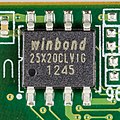This article is written like a personal reflection, personal essay, or argumentative essay that states a Wikipedia editor's personal feelings or presents an original argument about a topic.(July 2009) |
In computing, instant-on is the ability to boot nearly instantly, allowing to go online or to use a specific application without waiting for a PC's traditional operating system to launch. Instant-on technology is today mostly used on laptops, netbooks, and nettops because the user can boot up one program, instead of waiting for the PC's operating system to boot. This allows a user to launch a single program, such as a movie-playing program or a web browser, without the need of the whole operating system. There still remain a few true instant-on machines such as the Atari ST, as described in the Booting article. These machines had complete Operating Systems resident in ROM similar to the way in which the BIOS function is conventionally provided on current computer architectures. The "instant-on" concept as used here results from loading an OS, such as a legacy system DOS, with a small hard drive footprint. Latency inherent to mechanical drive performance can also be eliminated by using Live USB or Live SD flash memory to load systems at electronic speeds which are orders of magnitude faster.[ citation needed ]
